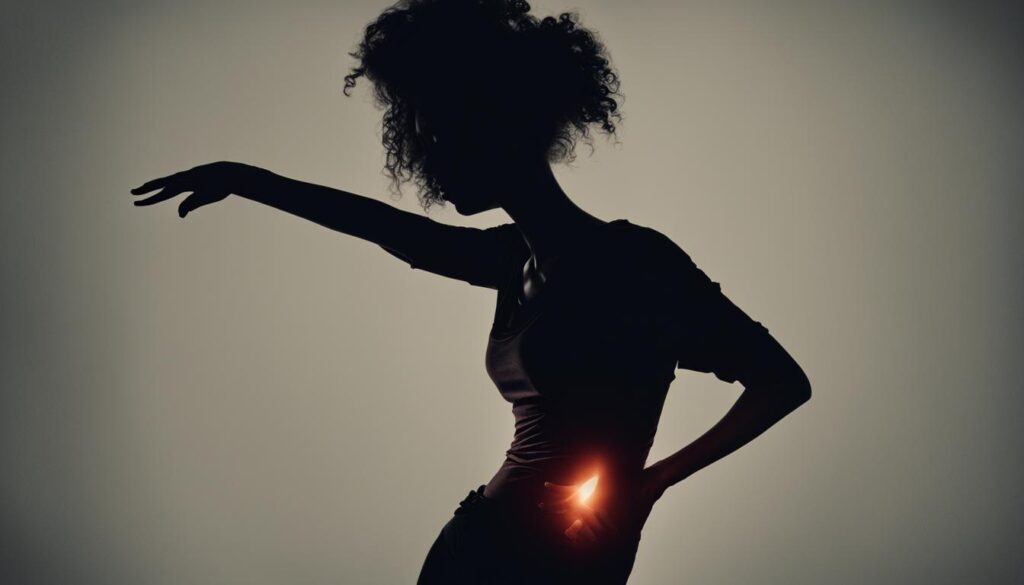If you’re experiencing cramps on your right side without a period, it can be quite puzzling. Cramps are commonly associated with menstruation, but when they occur without the arrival of your period, it may indicate an underlying issue. Understanding the potential causes behind these cramps is essential in order to seek appropriate treatment and alleviate any discomfort. Let’s explore some of the possible reasons for cramps on the right side without a period.
Key Takeaways:
- Cramps on the right side without a period can have various underlying causes.
- Conditions such as inflammatory bowel disease, ovulation, ruptured ovarian cysts, pregnancy, ectopic pregnancy, miscarriage, endometriosis, pelvic inflammatory disease, pelvic-floor muscle dysfunction, interstitial cystitis, irritable bowel syndrome, appendicitis, and ovarian cancer can all be potential factors.
- If you experience persistent or worsening cramps, it is important to seek medical evaluation and consult a healthcare professional for a proper diagnosis.
- Identifying the underlying cause is crucial in order to receive appropriate treatment.
- Remember, self-diagnosis is not recommended, and it is always best to consult a medical professional for personalized advice.
Inflammatory Bowel Disease (IBD)
Inflammatory bowel disease (IBD) is a chronic condition characterized by inflammation in different parts of the digestive tract. Two main types of IBD are Crohn’s disease and ulcerative colitis, both of which can cause cramps and discomfort on the right side of the abdomen.
With Crohn’s disease, the inflammation can occur anywhere in the digestive tract, from the mouth to the anus. Cramps and pain are commonly experienced in the right lower or middle parts of the belly. Ulcerative colitis, on the other hand, primarily affects the colon and rectum, leading to cramping and discomfort on the lower left side of the stomach.
| Type of IBD | Location of Cramps |
|---|---|
| Crohn’s Disease | Right lower or middle belly |
| Ulcerative Colitis | Lower left side of the stomach |
It is important to note that IBD is a chronic condition that requires ongoing management and treatment. If you are experiencing cramps on the right side without a period, it is crucial to see a healthcare professional for an accurate diagnosis and appropriate management strategies.
Ovulation
Ovulation is a natural process in a woman’s menstrual cycle where an egg is released from the ovary. This process typically occurs around 10-14 days before the start of the next period. Ovulation can cause cramps on one side of the lower belly, a phenomenon known as mittelschmerz. The word “mittelschmerz” translates to “middle pain” in German, referring to the location and timing of the discomfort.
The pain associated with ovulation can vary from person to person. Some women may experience a sharp, intense pain, while others may feel a dull ache. The pain can last anywhere from a few minutes to a few hours. It is important to note that not all women experience ovulation pain, and the severity and duration can vary from cycle to cycle.
The exact cause of ovulation pain is not fully understood, but it is believed to be related to the stretching of the ovarian wall as the egg is released. Hormonal changes during ovulation can also contribute to the discomfort. In most cases, ovulation pain is harmless and does not require medical intervention. Over-the-counter pain relievers and applying a heating pad to the lower abdomen may help alleviate the discomfort.
Ruptured Ovarian Cyst
One possible cause of cramps on the right side without a period is a ruptured ovarian cyst. When an ovarian cyst bursts or ruptures, it can cause sudden and sharp cramps in the lower stomach, below the belly button. The pain may be localized to one side or felt on both sides of the lower belly. In addition to cramping, other symptoms of a ruptured ovarian cyst may include spotting, pain or pressure in the lower belly, thighs, or lower back.
It’s important to note that not all ovarian cysts cause symptoms, and they can often go unnoticed. However, when a cyst ruptures, it can cause significant pain and discomfort. If you experience severe or worsening cramps on the right side, along with other symptoms such as heavy bleeding, fever, or dizziness, it is crucial to seek immediate medical attention.
Diagnosing a ruptured ovarian cyst typically involves a physical examination, pelvic ultrasound, and possibly other imaging tests. Treatment options may vary depending on the severity of symptoms and the individual’s overall health. In some cases, pain medication and supportive care may be sufficient, while others may require more intensive interventions, such as surgery, to remove the cyst or manage complications.
| Symptoms of Ruptured Ovarian Cyst | Treatment Options |
|---|---|
| Sharp, sudden cramps on one or both sides of the lower belly | Pain medication |
| Spotting or abnormal vaginal bleeding | Supportive care |
| Pain or pressure in the lower belly, thighs, or lower back | Surgical intervention (in severe cases) |
“A ruptured ovarian cyst can cause sudden and sharp cramps in the lower stomach, below the belly button. If you experience severe or worsening cramps on the right side, along with other symptoms such as heavy bleeding, fever, or dizziness, it is crucial to seek immediate medical attention.”
Pregnancy Pain
During early pregnancy, it is normal to experience various discomforts as your body goes through changes to accommodate the growing baby. One common symptom is cramps, which can sometimes be mistaken for period pain. These cramps are often referred to as implantation pain and typically occur around 4 weeks into the pregnancy.
The cramps associated with implantation pain are usually mild and may feel similar to period cramps. They can be accompanied by other early pregnancy symptoms such as breast tenderness, fatigue, and mood swings. It is important to note that not all women will experience implantation pain, and its intensity can vary from person to person.
It is essential to differentiate between normal pregnancy discomfort and more serious conditions. If your cramps are severe, persistent, or accompanied by heavy bleeding, it is important to consult your healthcare provider as these may be signs of a potential miscarriage or ectopic pregnancy.

In conclusion, cramps during early pregnancy are common and often referred to as implantation pain. While they are usually mild and nothing to be concerned about, it is important to monitor their intensity and any accompanying symptoms. If you experience severe or persistent cramps, heavy bleeding, or have any concerns, it is always best to consult with your healthcare provider for a proper evaluation and guidance.
Ectopic Pregnancy
Cramps on the right side without a period may be indicative of an ectopic pregnancy, a serious medical condition that requires prompt attention. In an ectopic pregnancy, the fertilized egg implants outside the uterus, most commonly in the fallopian tube. This can cause mild cramps initially, followed by sudden, sharp, stabbing pains on one side of the lower belly. Other symptoms may include vaginal bleeding, dizziness, lightheadedness, and shoulder pain.
If you suspect you may have an ectopic pregnancy, it is crucial to seek immediate medical assistance. An ectopic pregnancy can be life-threatening if left untreated, as it can lead to internal bleeding and organ damage. A doctor will perform a physical examination, order blood tests, and conduct an ultrasound to diagnose an ectopic pregnancy. Treatment options may include medication to dissolve the pregnancy or surgery to remove the affected tissue.
“It is important to seek medical attention right away if you experience severe abdominal pain, especially if it is accompanied by vaginal bleeding. Ectopic pregnancies require immediate treatment to prevent complications.”
Key Points:
- Ectopic pregnancy occurs when a fertilized egg implants outside the uterus, commonly in the fallopian tube.
- Cramps on the right side without a period, accompanied by sharp, stabbing pains, may be signs of an ectopic pregnancy.
- Vaginal bleeding, dizziness, lightheadedness, and shoulder pain are additional symptoms to watch out for.
- Immediate medical attention is essential to diagnose and treat an ectopic pregnancy.
- Treatment options include medication or surgery, depending on the severity of the condition.
Miscarriage
A miscarriage is a devastating event that involves the loss of an unborn baby before the 20th week of pregnancy. Cramps are a common symptom of a miscarriage, and they may start out as period-like pains and progress to more severe cramping. Vaginal bleeding or spotting is also a significant indication of a miscarriage. It is essential for anyone experiencing these symptoms to seek immediate medical attention.
Miscarriages can occur due to various reasons, including chromosomal abnormalities, hormonal imbalances, maternal health conditions, or structural abnormalities of the uterus. The exact cause of a miscarriage can often be difficult to determine, adding to the emotional distress experienced by those who go through it.
During a miscarriage, the body naturally expels the pregnancy tissue, causing cramping and bleeding. This process can be physically and emotionally painful, and it is essential to seek support from healthcare professionals, family, and friends during this time.

Endometriosis
Endometriosis is a chronic condition that affects the reproductive system. It occurs when tissue similar to the lining of the uterus grows outside of it. This abnormal tissue growth can cause a range of symptoms, including period cramps and pelvic pain.
Women with endometriosis may experience regular period-like cramps, which can be more severe than typical menstrual cramps. These cramps often occur in the lower abdomen and may radiate to the lower back. The intensity of the pain can vary from mild to debilitating, and it may worsen during menstruation.
In addition to cramps, endometriosis can cause chronic pelvic pain that persists throughout the menstrual cycle. This pain can significantly impact a woman’s quality of life and may interfere with daily activities. Other symptoms of endometriosis can include pain during sexual intercourse, heavy or irregular periods, and difficulty getting pregnant.
| Symptoms of Endometriosis | Common Treatments |
|---|---|
|
|
If you suspect that you may have endometriosis, it is important to consult with a healthcare professional. They can evaluate your symptoms and provide a proper diagnosis. Treatment options for endometriosis vary depending on the severity of the condition and the individual’s goals for managing their symptoms. With the right medical guidance, many women with endometriosis can find relief and improve their quality of life.
Pelvic Inflammatory Disease (PID)
Pelvic inflammatory disease (PID) is a common condition characterized by a bacterial infection that affects the reproductive organs. It can cause cramps on both sides of the lower belly and lower back, along with other symptoms. PID is often caused by sexually transmitted infections, such as gonorrhea or chlamydia.
The infection spreads from the vagina to the cervix, uterus, fallopian tubes, and ovaries, leading to inflammation and discomfort. Common symptoms of PID include abnormal vaginal discharge, pain during sex or urination, heavier or longer periods, and general pelvic pain. If left untreated, PID can lead to serious complications, including infertility and chronic pelvic pain.
Prevention and Treatment
Preventing PID involves practicing safe sex, using condoms, getting regular screenings for sexually transmitted infections, and treating any infections promptly. It is important to seek medical attention if you experience symptoms of PID or suspect an infection.
Treatment for PID typically involves a course of antibiotics to clear the infection. In some cases, hospitalization may be necessary, particularly if the infection is severe or if there are complications. It is essential to complete the full course of antibiotics as prescribed by the healthcare provider to ensure the infection is fully eradicated.
| Signs and Symptoms of PID | Treatment |
|---|---|
| Cramps on both sides of the lower belly and lower back | Antibiotics to clear the infection |
| Abnormal vaginal discharge | Hospitalization in severe cases or with complications |
| Pain during sex or urination | Completing the full course of antibiotics |
| Heavier or longer periods | Seeking medical attention promptly |
| General pelvic pain | Practicing safe sex and using condoms |
| Regular screenings for sexually transmitted infections |
If you suspect you may have PID or are experiencing symptoms, it is important to consult a healthcare professional for a proper diagnosis and treatment plan. Early detection and treatment can help prevent complications and promote reproductive health.
Conclusion
Cramps on the right side without a period can be a cause for concern, but there are various underlying factors that may contribute to this discomfort. It is important to seek medical evaluation if you experience persistent or worsening cramps. A healthcare professional can conduct tests and exams to determine the cause and recommend appropriate treatment.
Understanding the underlying causes of cramps without a period is crucial for effective management. Inflammatory bowel disease, ovulation, ruptured ovarian cysts, pregnancy, ectopic pregnancy, miscarriage, endometriosis, pelvic inflammatory disease, and other conditions can all contribute to the presence of cramps on the right side.
If you are experiencing cramps without a period, it is essential to consult a healthcare professional for a proper diagnosis. They can provide guidance and recommend appropriate treatment options based on your specific symptoms and medical history. Remember, self-diagnosis is not advisable, and a medical evaluation is always recommended.
FAQ
Why do I have cramps on my right side but no period?
Cramps on the right side without a period can be caused by various factors. It is important to identify the underlying cause to determine the appropriate treatment.
What is inflammatory bowel disease (IBD)?
Inflammatory bowel disease refers to chronic inflammation in different parts of the digestive tract. Crohn’s disease can cause cramps and pain in the right lower or middle parts of the belly, while ulcerative colitis typically causes cramps on the lower left side of the stomach.
Can ovulation cause cramps on one side of the lower belly?
Yes, ovulation can cause cramps on one side of the lower belly, known as mittelschmerz. This happens when the ovaries release an egg, typically about 10-14 days before the period. The pain can be sharp or dull and may switch sides each month.
What can cause sudden, sharp cramps on either side of the lower stomach?
A ruptured ovarian cyst can cause sudden, sharp cramps on either side of the lower stomach, below the belly button. Other symptoms may include spotting, pain or pressure in the lower belly, thighs, or lower back.
Can pregnancy cause cramps on the right side?
During early pregnancy, the growing baby attaches to the lining of the womb, causing implantation pain. This can manifest as slight cramps that resemble period pain around 4 weeks into the pregnancy.
What is ectopic pregnancy?
An ectopic pregnancy occurs when a fertilized egg implants outside the uterus, typically in the fallopian tube. This can cause mild cramps followed by sudden, sharp, stabbing pains on one side of the lower belly.
Can a miscarriage cause cramps on the right side?
A miscarriage is the loss of an unborn baby before the 20th week of pregnancy. Cramps associated with a miscarriage may start out as period-like pains and progress to more severe cramping. Vaginal bleeding or spotting may also occur.
What is endometriosis?
Endometriosis is a chronic condition where tissue similar to the lining of the uterus grows outside of it. This can cause regular period-like cramps and pain in the lower back and stomach below the belly button. Pain during sex and difficulty getting pregnant may also be present.
What is pelvic inflammatory disease (PID)?
Pelvic inflammatory disease is a bacterial infection that affects the reproductive organs. It can cause pain on both sides of the lower belly and lower back, abnormal vaginal discharge, pain during sex or urination, heavier or longer periods, and other symptoms.
What should I do if I have cramps on the right side without a period?
Cramps on the right side without a period can have various underlying causes. It is important to seek medical evaluation if the cramps persist or worsen. A doctor can conduct tests and exams to determine the cause and recommend appropriate treatment. Remember to always consult a healthcare professional for a proper diagnosis.




